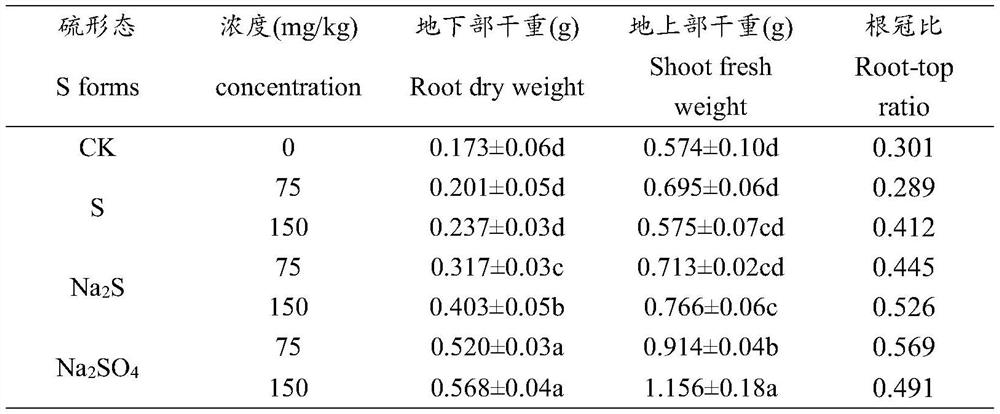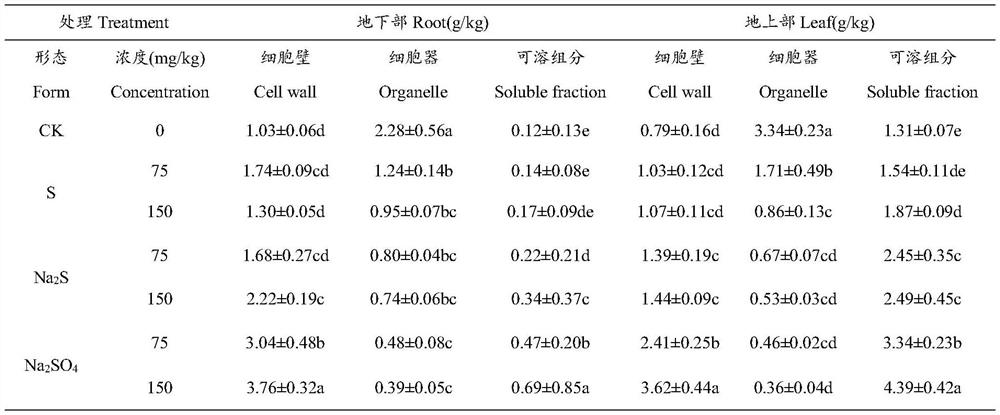Regulation and control method for promoting excessive absorption and accumulation of lead by Arabis alpina Linn. var. parviflora Franch. through mediation of sulfur
A technology of Arabidopsis thaliana and sulfur, applied in the field of plants
- Summary
- Abstract
- Description
- Claims
- Application Information
AI Technical Summary
Problems solved by technology
Method used
Image
Examples
Embodiment 1
[0037] The sulfur-mediated method for promoting the excessive absorption and accumulation of lead in plants A. floretus comprises the following steps:
[0038] S1, soil selection:
[0039] Take the farmland soil near the abandoned slag pile, which is the soil for planting corn in the 0-20cm plow layer, pass through a 2mm sieve after air drying, and put it in a plastic pot for later use;
[0040] S2, plant planting:
[0041] Use the seeds of A. thaliana to grow seedlings in substrate soil until the seedling stage, select seedlings with similar growth conditions, transplant them into pots respectively, and water them with 1 / 2 Hoagland nutrient solution every 2 days;
[0042] S3, sulfur solution preparation:
[0043] Prepare 3 different sulfur forms: Sulfur S 0 , sodium sulfide Na 2 S, sodium sulfate Na 2 SO 4 , sulfur S 0 , sodium sulfide Na 2 S, sodium sulfate Na2 SO 4 The treatment concentration is 0mg·.kg -1 , 75mg·kg -1 , 150mg·kg -1 ;
[0044] S4, sulfur treatm...
Embodiment 2
[0064] This embodiment provides a test experiment on the regulation method of the above-mentioned sulfur-mediated promotion of excessive absorption and accumulation of lead in the plant A. floretii. The specific experimental steps are as follows:
[0065] 1 Materials and methods
[0066] 1.1 Experimental materials
[0067] Soil for test: taken from Sanduoduo Village, Zhehai Town, Huize County, Yunnan Province (altitude 2463-2516m, east longitude 103°03′-103°55′, north latitude 25°48′-28°38′, near the abandoned slag pile) The farmland soil is the soil for planting corn in the 0-20cm plow layer. After air-drying, pass through a 2mm sieve, accurately weigh 5.0kg, and put it in a plastic pot (length 44cm×width 15cm×height 19cm) for use. Its main physical and chemical properties are listed in Table 1.
[0068] Table 1 Physical and chemical properties of the tested soil
[0069]
[0070] Plants to be tested: Use the seeds of A. thaliana to grow seedlings in substrate soil to t...
PUM
| Property | Measurement | Unit |
|---|---|---|
| concentration | aaaaa | aaaaa |
Abstract
Description
Claims
Application Information
 Login to View More
Login to View More - R&D
- Intellectual Property
- Life Sciences
- Materials
- Tech Scout
- Unparalleled Data Quality
- Higher Quality Content
- 60% Fewer Hallucinations
Browse by: Latest US Patents, China's latest patents, Technical Efficacy Thesaurus, Application Domain, Technology Topic, Popular Technical Reports.
© 2025 PatSnap. All rights reserved.Legal|Privacy policy|Modern Slavery Act Transparency Statement|Sitemap|About US| Contact US: help@patsnap.com



